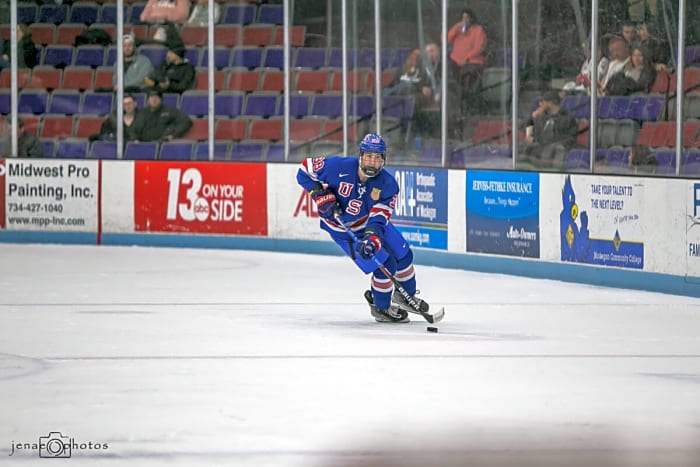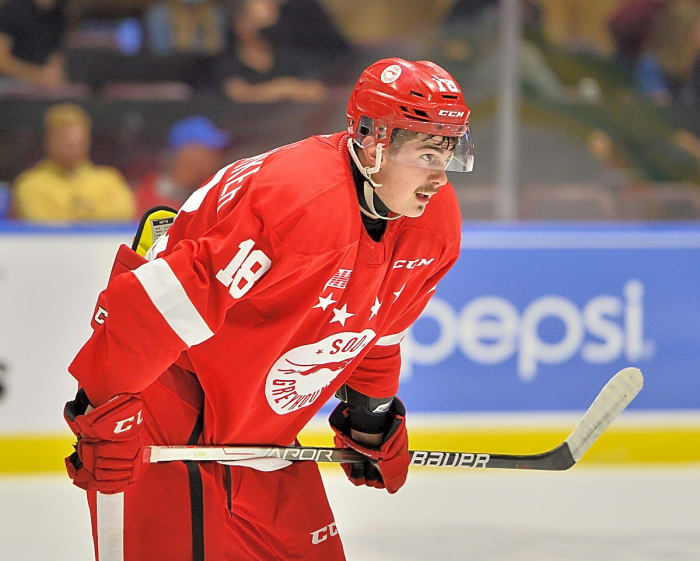
I first discovered the prospect pyramid as a 14-year-old, sitting in bed watching the famous hockey YouTuber Steve Dangle create one for his favorite team, the Toronto Maple Leafs. I was captivated by his 2019–2020 prospect pyramid and became fascinated by the world of NHL prospects and its development system. Now, I’m ready to create a prospect pyramid of my own for my favorite NHL team: the New York Rangers.
After giving the Rangers a B grade in my 2025 NHL Draft Class Ranking article, I’ll take a closer look at the team’s overall prospect pool and see how it stacks up against the rest of the league.
Rangers Prospect Pyramid Guidelines:
Not every Rangers player with some room for development is a prospect. Rather, three rules determine who qualifies as a prospect and who doesn’t.
Rule number one: Every prospect must have played 25 NHL games or fewer in their career. Once a player has appeared in more than 25 NHL games, they’re no longer eligible for the Calder Trophy (awarded to the league’s best rookie). At that point, they’re considered an NHL player rather than a prospect.
Rule number two: Every prospect must be under 25 years old. After about age 25, a player is typically viewed more as a project than a true prospect and is already in or nearing their prime.
Rule number three: Prospects must either be signed to an NHL contract or have their rights owned by the Rangers. This means players on American Hockey League-only contracts aren’t eligible here, nor are NCAA prospects who chose not to have their rights retained after three years.
The Rangers Prospect Pyramid Tiers
There are six tiers in the prospect pyramid.
Tier one: Generational talent.
Tier two: Elite talent. Think top-six forward, top pairing defenseman, or starting goalie.
Tier three: Middle-six forward, bottom-four defenseman, fringe starter goalie.
Tier four: A combination of players who have a lot of upside, but a low floor, as well as players who have pretty much hit their upside and don’t have much room left for development.
Tier five: Similar to tier four, but the players have less upside and lower floors.
Tier six: Everyone else.
Rangers Tier One Prospects: None
The Rangers don’t have any generational talents in their system, which is perfectly fine. Not many teams have generational prospects.
Tier Two: E.J. Emery, Gabriel Perreault, Brennan Othmann, Malcolm Spence, Dylan Roobroeck, Dylan Garand
Starting with the first-round picks, E.J. Emery was selected 30th overall in 2024 out of the US National Team Development Program (USNTDP) and just finished his freshman season at the University of North Dakota. On paper, Emery recorded only one assist in 31 games for the Fighting Hawks, but that doesn’t reflect his game. He’s a physical, steady defender who plays an important but often unsung role and has the potential to develop into a reliable shutdown presence for the Rangers.
Gabriel Perreault is expected to play a full NHL season next year after wrapping up an outstanding two years at Boston College. Following a five-game stint with the Rangers, Perreault will likely slot into middle-six minutes on the right wing. The 23rd overall pick from 2023 should be in the conversation for the Calder Trophy.
Brennan Othmann barely qualified for this prospect pyramid, as he sits exactly at 25 NHL games. In 22 appearances with the Rangers last season, he recorded just two assists, but that doesn’t tell the full story of the feisty left winger from Pickering, Ontario. The 16th overall pick from 2021 plays an aggressive, agitating style and, like Perreault, will spend the entire 2025-26 season on Broadway.
When I graded the 2025 NHL Draft, I gave the Malcolm Spence selection an A-plus. Spence should have been a first-round pick, but the Rangers were able to grab him 43rd overall. After an excellent year with the Erie Otters in the Ontario Hockey League (OHL), he’ll probably spend another season or two there before turning pro. I can see Spence developing into the power forward of the future for New York, and hopefully, the 18-year-old continues on that trajectory.
Dylan Roobroeck is my wild card for Tier Two. I covered him in detail in a previous article, but the 178th overall pick in 2023 already has a full American Hockey League (AHL) season under his belt with the Hartford Wolf Pack. At 20 years old, the 6-foot-7, 205-pound forward tallied 34 points in 72 games, showing signs of becoming a dependable, physical presence who could earn a call-up next season.
After a mediocre 2023–24 season as Hartford’s starting goalie, Dylan Garand bounced back with a strong 2024–25 campaign. He posted a 20-10-8 record, a .913 save percentage, and a 2.72 goals-against average. Since goaltenders typically take longer to develop, I expect the 103rd overall pick from the 2020 Draft to spend a few more seasons in the AHL before making the jump to the Rangers.
Tier Three: Nathan Aspinall, Drew Fortescue, Adam Sykora, Noah Laba
Nathan Aspinall was the third-highest scorer on his OHL team, the Flint Firebirds. While his 47 points in 62 games aren’t eye-popping, they were enough to earn him a five-game call-up to the Wolf Pack as a 19-year-old. Selected 159th overall in 2024, Aspinall also brings impressive size at 6-foot-7 and 195 pounds. He will likely spend another season in the OHL, but I wouldn’t be surprised if he makes the jump to the AHL sooner rather than later.

After finishing his sophomore season at Boston College, Drew Fortescue has established himself as a steady defensive option and even earned a spot on Team USA’s World Junior roster. The Pearl River, New York, native will most likely play one more year at Boston College before moving to the AHL.
Adam Sykora just wrapped up his second season in the AHL. The 63rd overall pick from 2022 put up 30 points in 71 games with Hartford and will probably spend another full season developing there before earning a call-up to the NHL.
Noah Laba, selected 111th overall in 2022, completed three solid seasons at Colorado College in the NCAA before joining the Wolf Pack for 11 games. In that stint, he recorded five points, and he’s expected to play a full year in the AHL next season.
Related: Rangers Should Be All in on Bowen Byram Trade
Tier Four: Sean Barnhill, Artyom Gonchar, Mikkel Eriksen, Raoul Boilard, Bryce McConnell-Barker, Jaroslav Chmelar, Matthew Robertson
Sean Barnhill is a big, physical defender who barely produced offensively in the United States Hockey League (USHL). He’ll have a larger role next season as he heads to the NCAA. His NHL chances depend on whether he can develop an offensive game.
Artyom Gonchar, nephew of Sergei Gonchar, has the biggest question mark, given his size at just 156 pounds. He’s committed to the OHL’s Sudbury Wolves next season, moving from Russia’s Junior Hockey League (MHL) to North America for the first time.
Mikkel Eriksen was a solid fourth-round pick in 2025. He was over a point per game in the Swedish junior league and will continue developing in Sweden as he progresses to the pro level.
Raoul Boilard recorded 46 points in 53 Quebec Maritimes Junior Hockey League (QMJHL) games—a league known for its high scoring—and added nine points in 11 playoff games. The 6-foot-2 center needs to show more consistent offense before moving on to the AHL.

Bryce McConnell-Barker just completed his first full AHL season, with 15 points in 68 games. The 97th overall pick in 2022 must elevate his offensive production to stay on track.
At 6-foot-5 and 220 pounds, Jaroslav Chmelar also finished his first AHL season, putting up 29 points in 71 games. While he could earn an NHL call-up in 2025-26, he must improve defensively after finishing a minus-37.
Matthew Robertson, now 24, is in his final year as a prospect. Drafted 49th overall in 2019, he has plateaued since reaching the AHL. Last season, he tallied 25 points in 60 games and played two NHL contests. He’s a solid AHL defenseman but may be limited to an emergency call-up role if he can’t take the next step.
Tier Five: Felix Farhammar, Zeb Lindgren, Ty Henricks, Talyn Boyko
Felix Farhammar and Zeb Lindgren play in Sweden and put up mediocre numbers in juniors. They will probably spend a few more years in Sweden, but don’t be surprised if the Rangers don’t offer them contracts.
Ty Henricks completed his freshman season at Western Michigan University, culminating in a national championship. He plays a depth role for the team and will likely spend another three to four years in the NCAA, developing his game.
I spoke about Talyn Boyko in depth in a previous article, but he will most likely be the backup goalie for the Wolf Pack next season. He put up solid numbers in the ECHL and had a small stint in the AHL, and could turn out to be a decent backup goalie in the NHL.
Tier Six: Everyone Else
I could go through every single prospect in the Rangers’ system, but that would take too much time. The players above are the ones most likely to make the NHL, and the intent was to offer more clarity into the Rangers’ prospect pool.
While the Blueshirts’ pyramid isn’t the deepest, there are plenty of prospects who will be wearing the Rangers sweater in a few years, as well as some with an outside shot to make the NHL.
More must-reads:
- Top five Hart Trophy candidates through the first month of the NHL season
- CeeDee Lamb, George Pickens seemingly disciplined by Cowboys during ‘MNF’
- The 'NHL all-time goal leaders' quiz
Breaking News
Trending News
Customize Your Newsletter
 +
+
Get the latest news and rumors, customized to your favorite sports and teams. Emailed daily. Always free!








